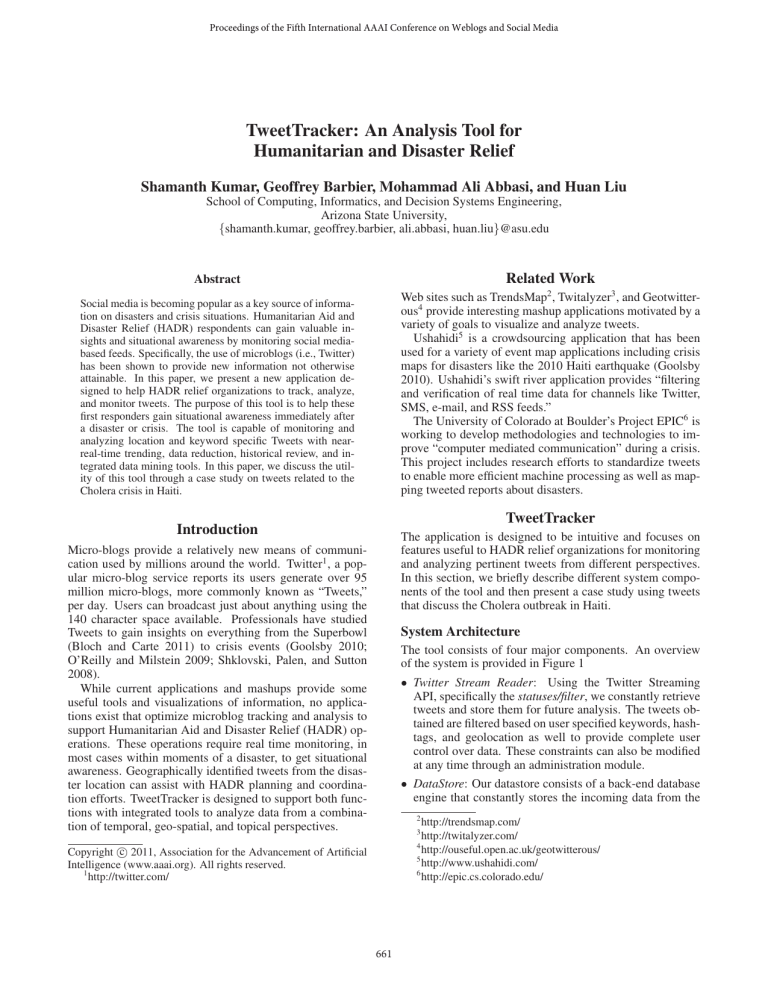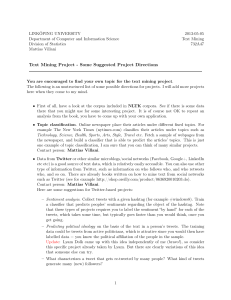
Proceedings of the Fifth International AAAI Conference on Weblogs and Social Media
TweetTracker: An Analysis Tool for
Humanitarian and Disaster Relief
Shamanth Kumar, Geoffrey Barbier, Mohammad Ali Abbasi, and Huan Liu
School of Computing, Informatics, and Decision Systems Engineering,
Arizona State University,
{shamanth.kumar, geoffrey.barbier, ali.abbasi, huan.liu}@asu.edu
Abstract
Related Work
Social media is becoming popular as a key source of information on disasters and crisis situations. Humanitarian Aid and
Disaster Relief (HADR) respondents can gain valuable insights and situational awareness by monitoring social mediabased feeds. Specifically, the use of microblogs (i.e., Twitter)
has been shown to provide new information not otherwise
attainable. In this paper, we present a new application designed to help HADR relief organizations to track, analyze,
and monitor tweets. The purpose of this tool is to help these
first responders gain situational awareness immediately after
a disaster or crisis. The tool is capable of monitoring and
analyzing location and keyword specific Tweets with nearreal-time trending, data reduction, historical review, and integrated data mining tools. In this paper, we discuss the utility of this tool through a case study on tweets related to the
Cholera crisis in Haiti.
Web sites such as TrendsMap2 , Twitalyzer3 , and Geotwitterous4 provide interesting mashup applications motivated by a
variety of goals to visualize and analyze tweets.
Ushahidi5 is a crowdsourcing application that has been
used for a variety of event map applications including crisis
maps for disasters like the 2010 Haiti earthquake (Goolsby
2010). Ushahidi’s swift river application provides “filtering
and verification of real time data for channels like Twitter,
SMS, e-mail, and RSS feeds.”
The University of Colorado at Boulder’s Project EPIC6 is
working to develop methodologies and technologies to improve “computer mediated communication” during a crisis.
This project includes research efforts to standardize tweets
to enable more efficient machine processing as well as mapping tweeted reports about disasters.
TweetTracker
Introduction
The application is designed to be intuitive and focuses on
features useful to HADR relief organizations for monitoring
and analyzing pertinent tweets from different perspectives.
In this section, we briefly describe different system components of the tool and then present a case study using tweets
that discuss the Cholera outbreak in Haiti.
Micro-blogs provide a relatively new means of communication used by millions around the world. Twitter1 , a popular micro-blog service reports its users generate over 95
million micro-blogs, more commonly known as “Tweets,”
per day. Users can broadcast just about anything using the
140 character space available. Professionals have studied
Tweets to gain insights on everything from the Superbowl
(Bloch and Carte 2011) to crisis events (Goolsby 2010;
O’Reilly and Milstein 2009; Shklovski, Palen, and Sutton
2008).
While current applications and mashups provide some
useful tools and visualizations of information, no applications exist that optimize microblog tracking and analysis to
support Humanitarian Aid and Disaster Relief (HADR) operations. These operations require real time monitoring, in
most cases within moments of a disaster, to get situational
awareness. Geographically identified tweets from the disaster location can assist with HADR planning and coordination efforts. TweetTracker is designed to support both functions with integrated tools to analyze data from a combination of temporal, geo-spatial, and topical perspectives.
System Architecture
The tool consists of four major components. An overview
of the system is provided in Figure 1
• Twitter Stream Reader: Using the Twitter Streaming
API, specifically the statuses/filter, we constantly retrieve
tweets and store them for future analysis. The tweets obtained are filtered based on user specified keywords, hashtags, and geolocation as well to provide complete user
control over data. These constraints can also be modified
at any time through an administration module.
• DataStore: Our datastore consists of a back-end database
engine that constantly stores the incoming data from the
2
http://trendsmap.com/
http://twitalyzer.com/
4
http://ouseful.open.ac.uk/geotwitterous/
5
http://www.ushahidi.com/
6
http://epic.cs.colorado.edu/
3
c 2011, Association for the Advancement of Artificial
Copyright Intelligence (www.aaai.org). All rights reserved.
1
http://twitter.com/
661
Twitter Stream
Reader
Provenance &
Geo-location
Module
DataStore
Tweets Entity &
Keyword Analyzer
Google Maps
Filtered Viewer
Data Visualization and Analysis Module
Google
Translation
Service
Keywords &
Hashtags Trend
Engine
Date based Tweet
Filter
Figure 3: Different analysis options, an example with tagclouds
User
Figure 1: System architecture of TweetTracker
Figure 4: Entity references in tweets
through Google Translate to aid user understanding. For
analysis, users choose from different views to allow streaming, streaming from a specific point in time, playback, and
playback with loop as shown in Figure 3. Emerging trends
are identified using tag cloud created from tweets. Entities
which may be referenced in tweets: relevant agencies/users,
additional hashtags, and hyperlinks that convey user sentiment can be previewed, as seen in Figure 4, to help users
understand who or what is being discussed.
Figure 2: Geolocated and normal tweets
stream reader, while supplying the visualization module
with requested data.
• Visualization and Analysis Module: This module is web
based and is the single point of user interaction with the
system. It is comprised of the following:
Future Work
– The map includes filters to focus on tweets of interest.
– The entity and keyword analyzer ranks entities contained within tweets including hashtags, hyperlinks,
and screen names. The analyzer generates frequent
keywords from tweets visualized as tag clouds.
– Date-based tweet filtering supports the analysis of older
tweets. The play mode helps visualize changes in
tweets through hashtags and entities.
– The keywords trending engine is used to generate
trends of keywords specified by the user.
Future efforts include optimizing displays, adding analysis features, and integrating additional microblog sources.
Feedback from relevant HADR agencies will serve as a basis for making improvements to the tool.
Acknowledgments
This work was supported, in part, by the Office of Naval
Research.
References
Bloch, M., and Carte, S. 2011. Twitter chatter during the
super bowl.
Goolsby, R. 2010. Social media as crisis platform: The
future of community maps/crisis maps. ACM Trans. Intell.
Syst. Technol. 1(1):1–11.
O’Reilly, T., and Milstein, S. 2009. The Twitter Book.
O’Reilly.
Shklovski, I.; Palen, L.; and Sutton, J. 2008. Finding community through information and communication technology
in disaster response. In Proceedings of the ACM 2008 conference on Computer supported cooperative work, 127–136.
ACM.
TweetTracker in Action
The application constantly monitors Twitter streaming feed 7
using specific keyword and hashtag filters related to the Haiti
cholera outbreak, for example #cholera and haiti cholera.
The primary mechanism for monitoring tweets is through
a map. Geotagged tweets are displayed on the map coordinates corresponding to the tweet. Tweets can be visualized on the map with specific color coding for geo-located
tweets (Green) and normal tweets (Blue) as shown in Figure 2. Tweets from different languages can also be translated
7
http://dev.twitter.com/doc/post/statuses/filter
662






